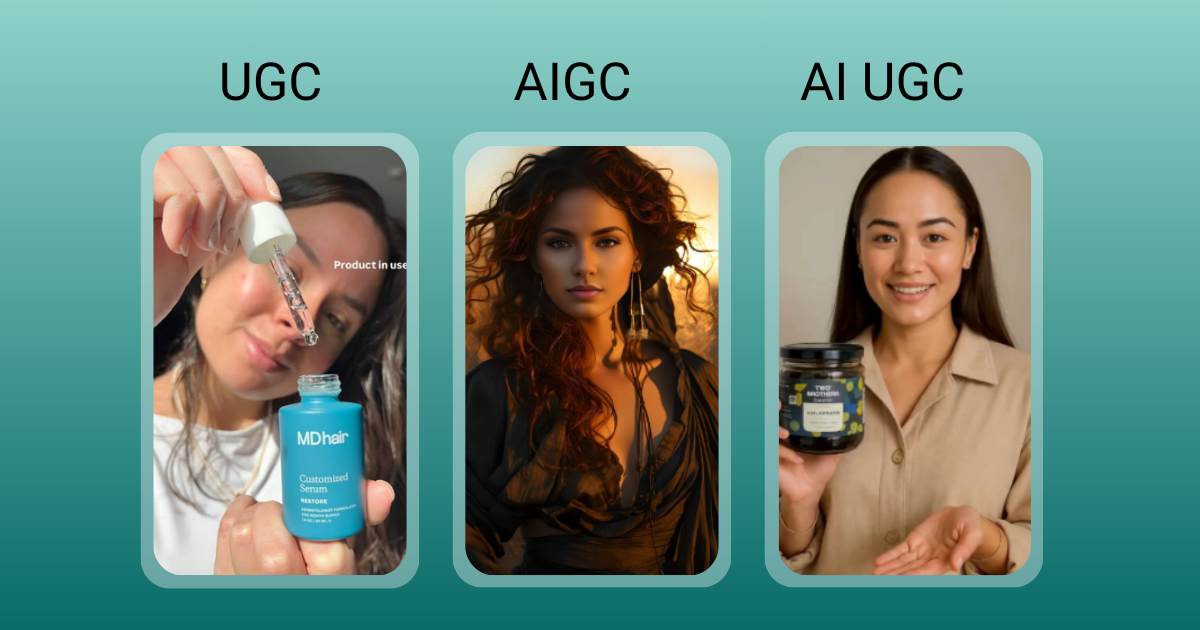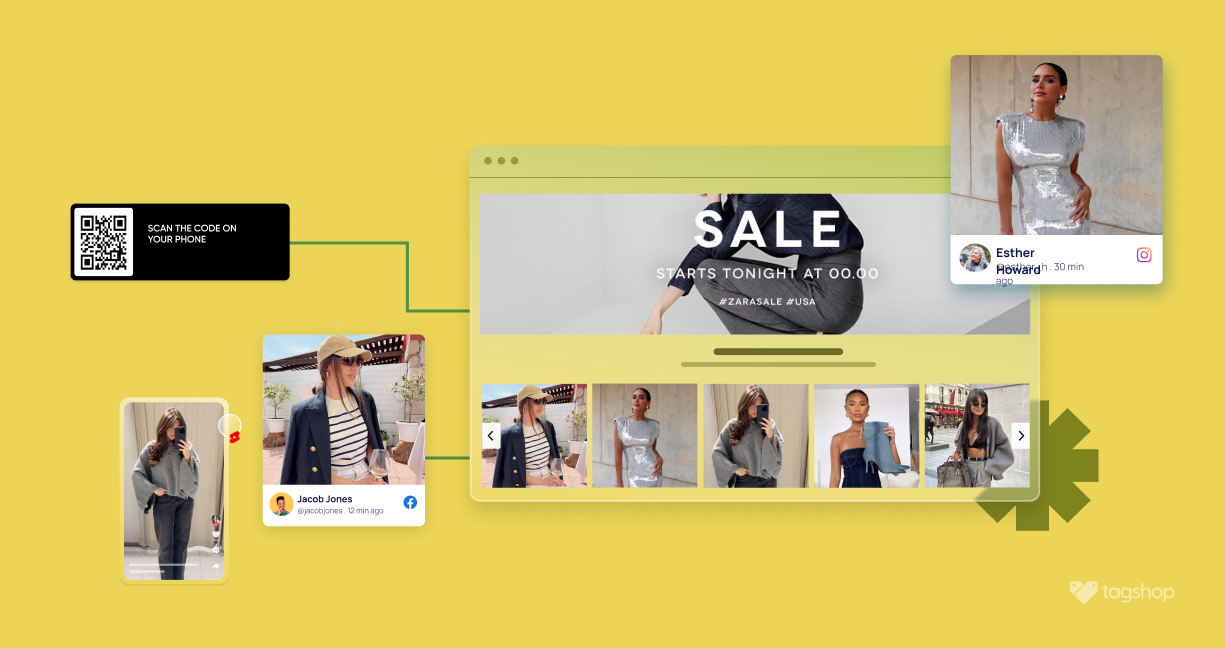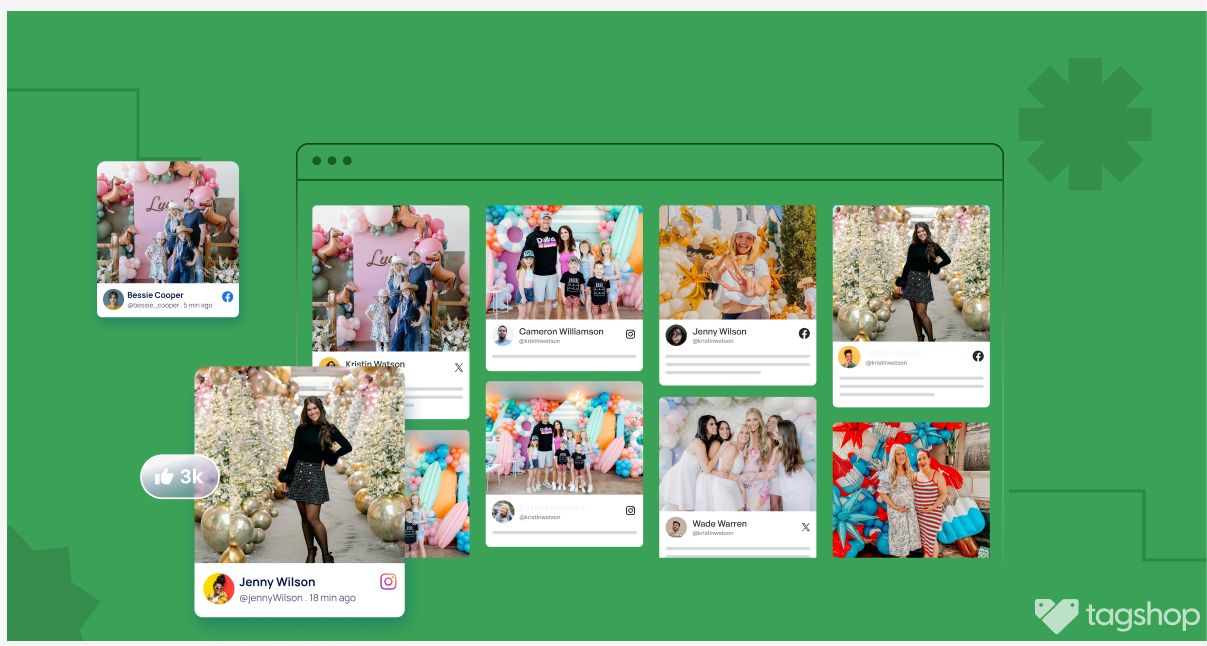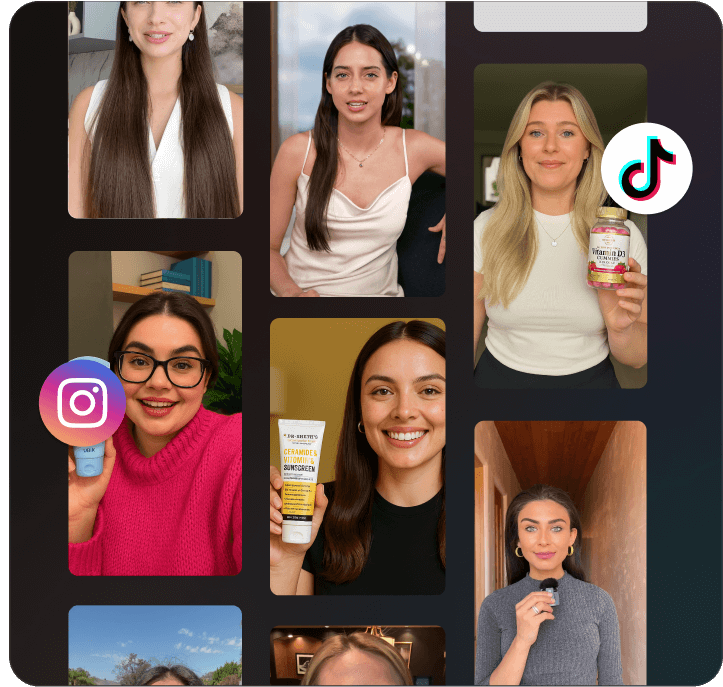8 Ways to Get User-Generated Content(UGC) for Your Brand
In 2023, Gymshark saw a massive surge in engagement when fitness influencers and everyday users shared workout videos featuring Gymshark apparel. The brand’s community-driven approach led to a 60% increase in online sales within a few months. Similarly, in 2020, Catrice Cosmetics reported an increase in sales within weeks after a YouTube video from Dutch make-up artist Nikkie de Jager. Many more such UGC examples highlight its impact. However, the question remains for many brands: How do we get user-generated content? This blog will answer that, but before that, let’s start with the basics.
What is User-Generated Content?
User-generated content refers to any text, images, UGC reviews, and social media posts created by customers or users rather than brands. It is a modernized version of word-of-mouth marketing, amplified by digital platforms. User-generated content helps customers learn about the brand and how its service or product can change their lives. For brands, it assists in gaining market recognition and reputation. As mentioned in the examples above, it also boosts sales for businesses.
Despite its advantages, acquiring UGC can be challenging. Brands must inspire users to create content, ensure it aligns with their guidelines, and navigate the complexities of permissions and content moderation.
8 Ways to Get User-Generated Content
Now that you have learned about user-generated content (UGC) and its impact let’s explore the topic in-depth and discover strategies for generating more UGC.
1. Make it Easy to Contribute
Businesses often make it difficult for consumers to partake in user-generated content, which reduces participation. Here are a few guidelines to consider to make it easy for consumers to generate content for your brand. Eventually, encourage your consumers to get involved in user-generated content for your brand.
2. Call to Action (CTA)
An inspiring call to action can convince your customers to share their experiences. Place CTAs wherever they are suitable, such as on your website, within your social media posts, or as part of your email campaigns. Make it visible everywhere and make sure it catches the attention.
Ensure the instructions are clear and straightforward; “Share your story with us” or “Tag us to get featured” might accomplish just that. A well-positioned CTA links your brand and its consumers and guides them in contributing customer-generated content.
A pop-up on a website, an announcement on social media, or a sign-off on a UGC campaign email presents effective CTAs by creating clarity and motivating user engagement.

3. Branded Hashtags
JustDoIt. Instantly, you think of Nike. That’s the power of a famous, unique, and branded hashtag. If you want people to generate content for your brand, then make sure you have a hashtag that is unique and that people can recognize.
Another example of an effective hashtag that received great user content submissions is #RedCupContest by Starbucks. This campaign by Starbucks during the holiday season encourages customers to share their UGC photos with iconic red cups. A branded hashtag makes organizing, locating, and repurposing user-generated content easy.
Hashtags also help build a sense of community amongst customers, making them feel part of your brand and eventually encouraging them to generate content.
4. Easy submission
Another reason you might not be getting great user-generated content is that your customers may be unable to figure out how to submit their content. A complex submission process often discourages consumers from posting any content.
To overcome this complex submission, one can say using social media hashtags is a simple way, but people who aren’t on social media won’t be able to use hashtags. This is where you can use tools that make it easy for consumers to submit their content; Tagshop is one such tool.
Tagshop enables you to make a form that you can circulate; using that form, your consumers can easily submit their content. The SnapUp feature allows users to upload pictures or UGC videos directly from mobile devices by simply taking pictures or recording a short video clip.

5. Contests and Giveaways
People love to participate in contests as it is a human desire for recognition and rewards. 45% of digital marketers say that social media contests have a good return on investment. You can run a contest to ask your customers to post a picture of your brand’s product.
You can ask them to showcase how they use your brand and how it can change their lives. The winners of the contest get discounts or exclusive prizes. Well-executed content is fruitful and helps you get more UGC for your brand.
6. Rewards and Recognition
GoPro gets its steady source of UGC as it runs GoPro Awards, a challenge that incentivizes users to create their content using GoPro and get rewards in return. One of GoPro’s most talked about contests is the Million Dollar Challenge, where customers use their GoPros, submit their videos, and win a chance to get $1 million.
In 2023, the 5th edition of this contest, they got over 40,000 clips, 66% more submissions than the previous edition. You can run contests and reward them with cash prizes, discounts, loyalty points, and more to amplify UGC for your brand.
6. Feature User Stories
People love getting acknowledged for their creativity and work, and showcasing UGC on your platforms builds loyalty and inspires others to contribute. You can share the content on social media platforms, which gives users pride in being featured and encourages others.
You can even embed social media feeds on your website as they become visible to visitors. Your customers get motivated to get a feature on your website, while you can build trust in your website visitors and convert potential customers into customers. In cases where these contributions tie into e-commerce, integrating reliable marketplace payment solutions ensures a smoother transaction flow alongside the engaging user experience.
Seeing users featured on a brand’s website encourages others to generate UGC for your brand and enjoy the spotlight on your website. Tagshop is among the most popular tools for simplifying this process; it helps collect UGC content and provides a social media widget to display.
7. Host events or contests to encourage users
Events, Pop-Ups, or Online Challenges that invite users to take and share their snaps are smart moves. Events equipped with photogenic spots and interaction points can drive spikes in UGC.
Experiential marketing works wonderfully to establish a bond between a customer and the brand. Shareable events, in particular, can create an organic boost in UG as attendees share their experiences.
8. Develop visually appealing products or packaging
Packaging matters. In social media, aesthetics play a key role in consumer behavior. Eye-catching and distinctive packaging has little to do with its appearance; it is more about shaping an experience for the consumer willing to share.
The more ‘Instagram-worthy’ the design, the more likely the product will organically appear in user-generated content spread throughout social media.
You can blame it on the unboxing culture. Brands must have packaging that is pleasing to the eye and grabs attention. While watching various unboxing videos from consumers, you might have noticed that they also discuss packaging.
Take Apple, for example. Their minimalist, high-end packaging creates a sense of excitement and exclusivity, prompting users to share their unboxing moments online.
Best Practices for Managing User-Generated Content
Once you have collected all the content, managing it is also part of UGC marketing. It ensures content aligns with brand values and enjoys UGC Content’s benefits. Here are ways you can manage them:
1. Establish Guidelines for UGC
Numerous UGC examples show that, when used correctly, it can boost brand awareness and help win customer trust. It should also give users a clear understanding of what is similar to the brand and a uniform corporate message and image.
In 2024, LEGO launched LEGO Life, a platform where fans can showcase their creativity, participate in challenges, and connect with other UGC Creators.
Using this platform, fans can post pictures and video ads of what they made, write about them, comment on them, and discuss them with other users.
In one initiative, LEGO asked fans to build landscapes and structures using LEGO. Providing clear guidelines and objectives helped them get more entries. LEGO now has a huge user-generated content to display; hence, there is no shortage of content even if they plan to indulge in paid advertising.
Before giving guidelines to your customers, be clear: What do you want people to create? Is it UGC reviews, testimonials, unboxing videos, or a more creative form related to your brand? Setting clear expectations helps users understand what is acceptable and valuable.
It also provides information on the expected tone and quality. You want to maintain a uniform brand image throughout all of UGC.
Driving users to implement these guidelines should help maintain desired consistency and avoid looming challenges when merging UGC into marketing campaigns. By clarifying things, brands can create a positive and constructive content-sharing environment.

2. Moderate UGC Responsibly
Sure, you have created guidelines and maintained a brand tone, but it isn’t sure that all consumers will follow them; they might miss some. To overcome that challenge, you can:
- Use Moderation Tools
Using moderation tools can make removing unwanted content easy and save you time. Various tools flag inappropriate content. The tool we mentioned above, Tagshop, helps you collect and display UGC content on your website and enables you to moderate it.
After collecting the UGC, you can manually remove the content or use the automation feature to remove it, as per your instructions.
- Have a Moderation Team
While automation can help, nuanced decision-making requires and is crucially dependent on a human moderator. A dedicated team of moderators who can examine content manually will ensure that all submissions are unwaveringly bound to the brand values and accurately represent them.
Moreover, this would engage the community directly, increasing the quality of the user experience.
- Create a Clear UGC Policy
A clear UGC policy that defines what is and is not acceptable will reduce disputes. This policy must be clearly stated on the website and in any campaign that calls for UGC submissions.
Brands can also encourage users to try again by providing feedback to those whose submissions did not meet the criterion.
- Keep a Balance Between Freedom and Control
Moderation is essential, but not at the cost of freedom. Too much control may suppress creativity and hinder participation.
Strive for a harmonious balance between allowing user expression and adherence to brand integrity. Tap into other perspectives and authentic storytelling to make user-generated content more impactful.
3. Obtain Permissions and Give Credit
We all know the importance of UGC content and its sharing rights. Once you have access to content from your customers, you must use it ethically and legally. Before using UGC, you should have all the required permissions to use that content. You must also appropriately credit the creators. This safeguards the brand’s reputation and fosters goodwill within the community.
Before including UGC in marketing assets, UGC ads, or official brand platforms, the UGC content creator must approve this. Such approval may be procured through a direct message, an email, or a simple reply to the original post. For example, if you write in the post, “We love your post! Can we share this on our official page?” This simple gesture can help you get permission for the content.
An organized permission system, such as a UGC submission form on the brand’s website, makes everything easier. Users can submit their content while checking the consent box, taking care of the legal part before their material is featured.
Benefits of UGC Content
After learning about strategies for obtaining more UGC and best practices, it is essential to consider the impact that proper implementation can have.
1. Give your Brand Authenticity.
Consumers are very concerned about authenticity these days. They want to know what they purchase and whether it is authentic. This generation doesn’t believe in branded content; they want authentic experiences and honest opinions. UGC provides an unfiltered and unbiased view of a product or service from the people who use it, thus making it more relatable and believable. When potential customers see real people giving great feedback, they are far more likely to trust the brand.
According to research, 92% of consumers trust organic, user-generated content more than other forms of traditional advertising. These statistics highlight why UGC should be promoted further to gain credibility and certify brand image.
2. Enhances Engagement
One of the most significant challenges for brands, no matter what, is engaging with the audience. UGC encourages more interaction by enhancing users’ participation in content generation. Whether through branded hashtags, contests, or challenges, UGC requires induction activities for the audience to engage with the brand.
The examples we mentioned at the start of the blog and others, such as GoPro and others from various brands, show how utilizing UGC has helped them increase engagement. This highlights the importance of user-generated content for brands, as good engagement helps brands establish themselves in the market.
3. Cost-Effectiveness
We all know advertising costs a lot, whether print or visual. Producing high-quality content also comes at a cost, as it requires various resources, such as a copywriter, photographer, designer, videographer, and more. UGC cuts all the costs spent on resources. It provides a more economical avenue for getting customers to provide content for the brand.
The painstaking task of professional production could be eliminated, and your brand could use pictures, short videos, posts, and other methods published by customers. This slogan is inexpensive in terms of production costs and creates content that resonates better with the target audience.
4. Boosts Social Proofs
Consumers trust their peers’ recommendations more than advertisements. UGC acts as very vigorous social proof, emphasizing real-life use cases and other customers’ positive experiences.
For instance, potential buyers who see positive reviews, unboxing videos, or testimonials from existing users will be more willing to buy. Companies that rely on user-generated reviews, such as TripAdvisor, Yelp, and Amazon, again succeed because they wield considerable influence over consumers’ choices.
5. Strengthen SEO and Online Visibility
User-generated content (UGC) significantly boosts a brand’s SEO process. Search engines prefer fresh, relevant, and diverse content. Since UGC is constantly updated and comes from numerous contributors, it helps raise organic search ranking.
User-generated content frequently contains keywords or phrases that prospective customers use when searching for products or services. When you embed UGC on a website, search engines crawl the content, and the keywords used in the content help boost your brand’s search engine ranking.
Moreover, UGC, including social media mentions, reviews, and blogs, creates backlinks that strengthen a brand’s SEO strategy. In other words, while UGC helps with social media, you can also use it to push your search engine ranking.
Conclusion
User-generated content (UGC) is a goldmine for marketers. It helps increase brand awareness and authenticity and builds brand-customer relationships. If managed strategically, UGC can be a game-changer for brands.
Remember that UGC is not just a marketing trend but a long-term strategy that builds more profound customer connections. In the long term, it helps build customer loyalty and gain market recognition. Using UGC, you can convert your customers into your designated brand ambassadors, creating a growing community.
In this blog, we learned about strategies for generating more UGC and guidelines for following them. So, what are you waiting for? Now that you are well versed in the strategies, apply them and get UGC for your brand to stand out.









